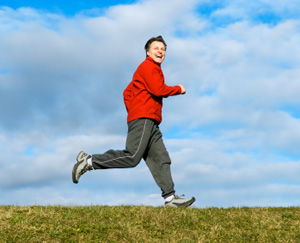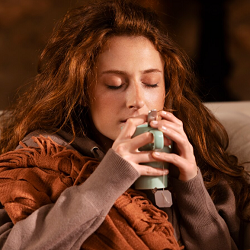Get Moving and Fibre Up to Lose That Spare Tire

An unhealthy apple
When it comes to disease risk, having an appleshape is less desirable than a pear shape, where fat is concentrated more around the thighs and buttocks. Extra abdominal fat—especially the stuff that surrounds the organs, called visceral fat—increases the risk of developing insulin resistance, which is a forerunner to diabetes. The fat that lies just below the skin’s surface (subcutaneous fat), doesn’t seem to be as strongly linked to diabetes risk.
In an effort to better understand what contributes to abdominal fat, researchers involved in the Insulin Resistance and Atherosclerosis Family Study (IRAS) asked 1,114 Hispanic Americans and African Americans (average age 42 years at the beginning of the study) about lifestyle aspects including dietary patterns, smoking history, and physical activity. The participants’ height, weight, and abdominal fat mass (calculated by CT scan) were measured at the beginning of the study and five years later.
More fibre, please
Researchers found that the people who ate more soluble fibre and engaged in regular exercise were less likely to gain visceral abdominal fat over the years, regardless of changes in BMI (body mass index). For each 10-gram-per-day increase in soluble fibre, the rate of visceral fat accumulation went down by almost 4%.This effect was most pronounced in African American men. Soluble fibre didn’t seem to affect the way subcutaneous fat was deposited around the body.
Exercise also helped keep visceral fat accumulation down over the years. Engaging in vigourous physical activity (defined as participating in exercise that makes you sweat, or increases the heart rate or breathing rate) one to four times per week had a 7.4% decrease in the rate of visceral fat accumulation and a 3.6% decrease in subcutaneous fat accumulation.
Current smokers tended to have slightly less accumulation of subcutaneous fat, but smoking status didn’t affect how much visceral fat the people accumulated.
“Although the fibre–obesity relationship has been extensively studied, the relationship between fibre and specific fat depots has not,” commented the study’s authors. “Our study is valuable because it provides specific information on how dietary fibre, specifically soluble fibre, may affect weight accumulation, specifically through abdominal fat deposits.”
Changing for good
Adopting a new way of eating and committing to a regular exercise routine can seem overwhelming, but little changes can add up to big health benefits over time.
- Start by swapping out some of the processed foods in your grocery cart for whole food versions of the same foods. For example, choose whole grain varieties of your favourite breads and pastas. Also, opt for baking your own treats so you can use less sweetener and replace some of the white flour with whole grain flours.
- Include fruits and vegetables at every meal to help ensure that you’re getting your 5-a-day of these nutrition powerhouses. Soluble fibre is found primarily in fruits, vegetables, and pulses like beans and lentils. An easy way to boost your fruit and vegetable intake is to mix them into a smoothie. Experiment with different combinations; spinach usually goes unnoticed in a drink that’s heavy on the berries and sweet fruits like pineapples, grapes, and bananas.
- Take baby steps toward your exercise goals. If you’re not exercising at all right now, walking around the block three times a day is a huge improvement. Don’t try to do it all at once. Set reasonable goals for yourself and build up the duration and intensity of your exercise sessions over time. Finding a buddy to work out with can help motivate you when it’s tough to get moving.
(Obesity 2011;doi:10.1038/oby.2011.171)
Copyright © 2024 TraceGains, Inc. All rights reserved.



 Lehmann&Voss&Co. and the LEHVOSS Group will be presenting their range of high-quality minerals at Food...
Lehmann&Voss&Co. and the LEHVOSS Group will be presenting their range of high-quality minerals at Food...  We are pleased to announce our new partnership with Zooca® The Calanus® Company for
We are pleased to announce our new partnership with Zooca® The Calanus® Company for 
 Calcium is well-known for its health benefits, especially for athletes and active individuals....
Calcium is well-known for its health benefits, especially for athletes and active individuals....  New
New 






































